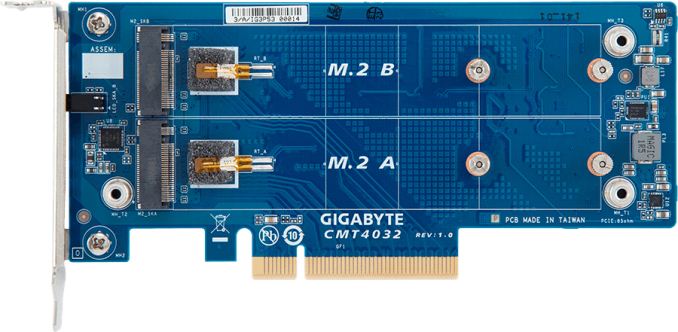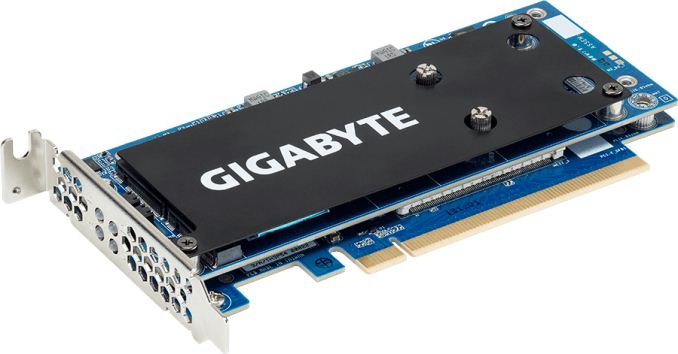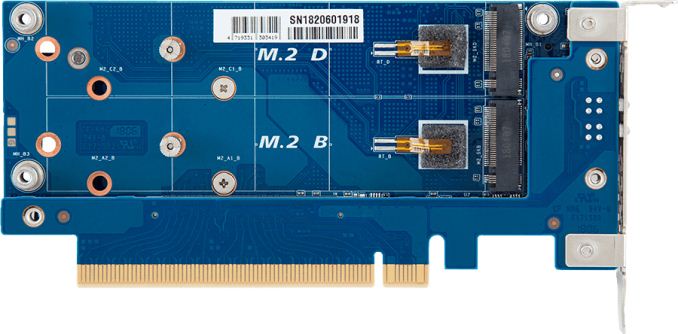GIGABYTE Launches CMT4030-Series PCIe 3.0 x8 and PCIe 3.0 x16 SSD Risers
by Anton Shilov on July 6, 2018 1:00 PM EST- Posted in
- SSDs
- Gigabyte
- Enterprise SSDs
- GIGABYTE Server
- SSD Risers

GIGABYTE B2B has launched two PCIe riser cards for M.2 SSDs designed to build ultra-fast storage sub-systems consisting of multiple M.2 drives. The CMT4030-series risers will be available through B2B channels, hence, to makers of servers, workstations, and high-end PCs rather than to DIY enthusiasts.
Neither of the GIGABYTE CMT4030-series cards use any PCIe switches and therefore rely on PCIe bifurcation supported by CPU or PCH (i.e., they will not work on cheap systems that have limited PCIe bifurcation capabilities) as well as on software RAID technologies supported by the platform. Both risers support M.2-2280 and M.2-22110 drives, they are equipped with their own thermal sensors and advanced VRMs to ensure quality power supply to SSDs.
GIGABYTE’s CMT4032 is a low-profile PCIe 3.0 x8 riser card that supports two M.2 drives and comes with an aluminum heat spreader. This card may be used inside higher-end consumer systems to build high-performance storage systems featuring two SSDs as well as a 6.5 GB/s throughput.
The CMT4034 low-profile PCIe 3.0 x16 riser card carries four M.2 drives on two PCBs that also has a passive cooling system. This riser is officially aimed only at GIGABYTE’s Purley generation servers, so their work on systems based on other Intel platforms (X299, X370, etc.) is not guaranteed. As for performance, maximum throughput supported by a PCIe 3.0 x16 slot is around 15.75 GB/s.
Pricing of GIGABYTE’s CMT4032 and CMT4034 SSDs risers is unknown, but since we are dealing with B2B products, it will vary depending on volumes and negotiations. The manufacturer plans to offer its 4-way Aorus PCIe x16 M.2 SSD riser for high-end desktops at some point in the future, but details are unclear.
Related Reading:
- GIGABYTE Aorus PCIe x16 M.2: For Four NVMe Drives, X399 Compatible
- Plextor Demonstrates 4-Way M9Pe Extreme SSD Solution: Up to 6.5 GB/s
- Marvell Launches New SSD Controllers And RAID-Capable NVMe Switch
- Kingston at CES 2018: A 6.4 TB U.2 Enterprise SSD with Four M.2 Behind a PEX Chip
- ASRock at CES 2018: Ultra Quad M.2 PCIe Card
- MSI Demos Prototype Hybrid Storage Card: M.2 & 2.5” SATA on a PCIe Card
Source: GIGABYTE














20 Comments
View All Comments
jrs77 - Friday, July 6, 2018 - link
I think it's a shame, that all those PCIe cards don't work in the PEG-slot of a mITX-board. It's time to get rid of the GPU-only restriction on those PCIe x16 slots on mITX-boards and open up the PCIe lanes to be used with all sorts of cards like TV-tuners, soundcards or and especially PCIe M.2 riser cards.Zan Lynx - Friday, July 6, 2018 - link
I have no idea what's limiting your board from using anything in that slot. I had a mITX AMD E350 board with one and it worked fine for an x4 eSATA controller. Try it and see what happens.shelbystripes - Friday, July 6, 2018 - link
WTF are you talking about dude? Every mITX board I’ve ever used, the PCIe slot is just a PCIe slot. Last one I set up was a Gigabyte board, I used the PCIe slot for a dual Intel GbE card and it worked just fine.jrs77 - Saturday, July 7, 2018 - link
The last 7 or 8 mITX boards I've owned, from Gigabyte, Asus or ASRock have all not recognized any TV-tuner or soundcard I've tested, but have accepted every GPU.All those boards I've had, have a PEG-slot (PCI Express Graphics) and these slots somehow don't work with anything else than a GPU. I can't tell you if this is restricted by the chipset or the BIOS. All I can tell you is what my experiences are for the last 10 years.
saratoga4 - Saturday, July 7, 2018 - link
Probably an issue with whatever boards you're using. The system itself won't care what card goes into what slot. PCIe is PCIe.CheapSushi - Friday, July 6, 2018 - link
Really wish there were dual and quad nvme adapter options for us with older boards that don't have bifurcation. I hope a cheaper PLX like switch comes out. =\ These looks nice though.MajGenRelativity - Saturday, July 7, 2018 - link
Applicata has a card that does just that. Be forewarned, it is pricey. PLX chips are mad expensive, so the card is expensiveCheapSushi - Wednesday, July 11, 2018 - link
It's neat for sure and like you said, pricey. But it's x8, not x16 sadly. The true x16 one is passive. I've stared at it a lot, almost clicking the buy button a few times.MajGenRelativity - Thursday, July 12, 2018 - link
Well, yeah. The x8 is the active one so you don't need bifurcation. I'm not aware of a PLX x16 oneAlexvrb - Saturday, July 7, 2018 - link
Why would you want to couple a very expensive PLX-equipped quad M.2 array with an old system?For that matter, outside of video editing... who even needs these?? They are basically only good for a crapton of sequential performance, which by itself isn't very helpful for most workloads. Worse yet I've seen these boards cause performance regression... and it's amplified if the board (like these cheap ones) rely on software RAID.
I can't help but picture a bunch of "enthusiasts" using these thinking it's going to boost their IOPS to the moon.